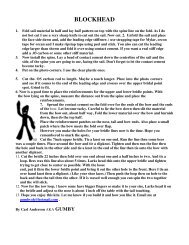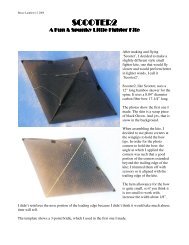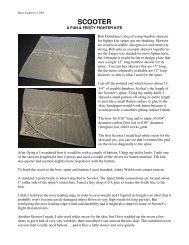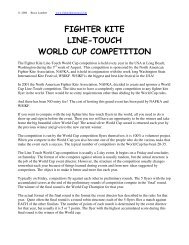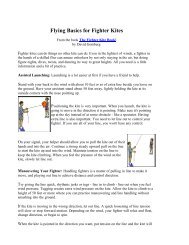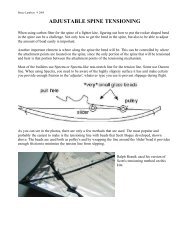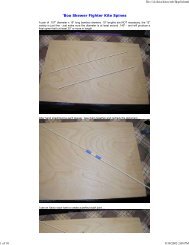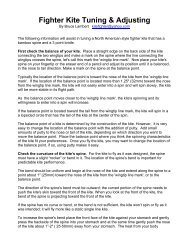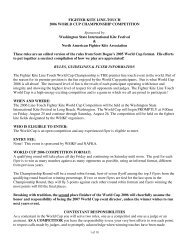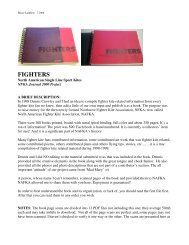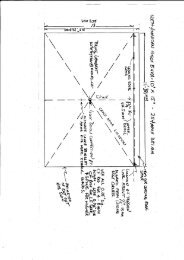Traditional Fighter Kite 2 Point Bridle - fighterkitecentral.com
Traditional Fighter Kite 2 Point Bridle - fighterkitecentral.com
Traditional Fighter Kite 2 Point Bridle - fighterkitecentral.com
- No tags were found...
You also want an ePaper? Increase the reach of your titles
YUMPU automatically turns print PDFs into web optimized ePapers that Google loves.
One World <strong>Kite</strong>s, Fort Worth, Texas, U. S. A.Anatomy of an Indian <strong>Fighter</strong> <strong>Kite</strong> :NoseBowABowSailXVUpper Anchor <strong>Point</strong>.SpineBYZClear Scotch Tape.SpineTailC<strong>Bridle</strong> ends - Fine Tuning.Lower Anchor <strong>Point</strong>.Scotch Tape Reinforcement Details.<strong>Bridle</strong> Details :A : Distance from upper tip to upper anchor point. Bow.B : Distance from upper anchor point to lower anchor point.C : Distance from lower tip to lower anchor point. Usually 1½ to 2 times A. Alternately C = 1/3 the length of the Spine.Most Indian <strong>Fighter</strong> <strong>Kite</strong>s, now have a little rectangular piece of sail material or such glued on back as reinforcementat lower anchor point area. Please use that as a guide.X : Length from upper anchor point to point Z.Y : Length lower anchor point to point Z.Z : Intersection of X and Z. Tie a Knot at Z.V : <strong>Kite</strong> line attach point.<strong>Bridle</strong> Guide.X : Should be equal to B.Y : Should be equal to B plus ½ inch to 1 and ½ inches. Depending on the size of the <strong>Kite</strong>.Note : <strong>Bridle</strong> should be a single length of line from the upper anchor point to point V, back to the lower anchor point.
Tuning an Indian <strong>Fighter</strong> <strong>Kite</strong> :The bridle of a kite sets the ‘angle of attack’ – this is the angle at which the kite faces the wind. By making fineadjustments to the bridle, you can change this angle and alter the flying characteristics of the kite to suit your ownpersonal taste. However, before attempting any tuning adjustments, try flying in slightly different wind conditions first,because very often an unstable wind will be the cause of your kite flying in an unpredictable manner.How Adjustments are made :If you look at the anchor points where the bridle is attached to the kite, you will see a short length of line hanging fromeach connection.These are left specifically for fine tuning the kite, and adjustments are made by shortening either sectionof the bridle. To adjust the bridle length at either connection point, twist the bridle line into a single small loop, thread theloose end of line through it, and pull into a knot. Try tying one knot at a time and then fly your kite and note the differenceit has made, repeating the process if necessary.If the <strong>Kite</strong> Spins too fast / too much :This usually means that the top section of the bridle is too short, so shorten the bottom section to correct it.If the <strong>Kite</strong> is too slow and does not Spin enough :Shorten the top section of the bridle, and this will make it faster.If the <strong>Kite</strong> consistently Spins to one side :The most likely cause will be that the bow is stronger on one side than the other. Make sure you have tested the <strong>Kite</strong> in asteady wind before making any adjustments. If the <strong>Kite</strong> spins more to the left, the bamboo is likely to be weaker on thatside. To <strong>com</strong>pensate for this you will need to weaken the opposite (right) side to balance the bow and correct the bias.Gently bend the bow between the thumb and forefinger of each hand, being careful not to break it. The adjustment shouldbe made some where near the point where the bow is fixed to the tissue, or slight closer to the center of the kite.Some fliers even nip the bamboo between their teeth, and it seems to work.




